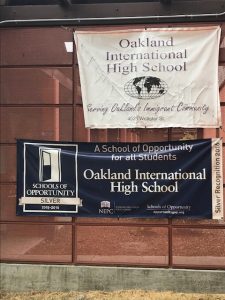Reflections on The Pandemic from an Oakland International High School Leader
By Carmelita Reyes, Founding Principal of Oakland International High School
This year of distance learning has challenged educators, parents, and students alike. A casual scroll through my Facebook feed illuminates a multitude of complaints in posts by teachers in my school district, the parents of my kids’ friends who don’t know how to support their children, and teenagers moaning about boring online lessons.
I have a unique perspective on the issue as I identify with all three groups. I became the primary distance learning parent this spring when schools closed and my 1st and 4th grader started online classes. The demands distance learning has put upon parents is entirely unreasonable. Parents are not teachers, computer technicians, or adequate replacement for peer socialization. We feel like failures. When I’m not working or parenting, I’m a doctoral student at UC Davis. This semester, all my classes are virtual, and I sit in zoom seminars from 9 am to 5 pm. At the end of the day, I’m a zoom zombie. In my professional life, I lead workshops and professional learning communities for district leaders who are learning how to support newly arrived immigrant students. During the pandemic, these workshops transitioned online. All of a sudden, I was a novice teacher struggling to create meaningful experiences in a virtual classroom.
I can honestly say that I don’t know who has it worse – the students sitting in front of zoom, the teachers having to re-think everything they know about how to deliver a lesson, or the parents who are stressed out supporting their kids at home. I think it is a tie and we should be sympathetic to all sides.
My own kids have missed lessons because we lost track of time or the zoom link didn’t work. Teachers’ directions were not clear – kids were frustrated. I’m frustrated. I’ve had more than a few fights with my kids who tell me, “YOU DON’T KNOW ANYTHING!” I have teaching awards that say otherwise, but this impresses no one in my house. The little one keeps disappearing from class when I’m not looking. His browser history shows a bunch of sites with poop jokes. Last week, I received a note from the teacher of my oldest child – he is missing several assignments including his mastery project. On Thursday the youngest somehow broke off the jack of his earphones inside the Chromebook. He could not hear or speak to his classmates for the rest of the day … This is the nonsense that happens in one of the most well-resourced homes in the county. Once upon a time, I was the Oakland Unified School District (OUSD) teacher of the year; I served as a principal at Oakland International High School (OIHS) for a dozen years. We have the money, technology, and the know-how to support our kids. We are all doing our best, and it is still a hot mess.
It sounds like I have a lot to complain about, yet my family’s frustrations can’t compare to what is happening to some of our most vulnerable students – newly arrived immigrants in OUSD. They don’t have parents who can navigate technology or adapt lessons to meet their needs. Their parents can’t write emails in English to teachers asking for directions to be clarified. Their parents can’t procure new headphones when they break.
Thanks to philanthropy, we have been able to put technology into the hands of Oakland students. Technology alone doesn’t make distance learning valuable it only makes it possible. Oakland International is staffed by some of the best teachers in the district. Yet, distance learning has rendered them and all other educators clumsy novices struggling to master new means of teaching in a virtual space. Even those who have incorporated new techniques into their toolbox have found them not nearly as effective as in person learning. Distance learning is a poor substitute for the rich interactions and differentiated instruction that previously characterized our school.
Perhaps the most distressing manifestation of the challenges of distance learning is the “blank screen” syndrome. In OUSD and most other Bay Area communities, students are not required to be “on camera.” There are a lot of valid reasons for this policy — poor internet connections and a family’s right to privacy to name a couple. However, the result is that teachers are not looking at a bunch of teenagers on zoom. Typically, teachers look out into a sea of blank screens. They teach into a void. Teachers lack visual cues of confusion, interest, boredom, or enthusiasm on the faces of students. They don’t know who is paying attention. In this scenario it is almost impossible to create an environment of student collaboration and peer to peer communication, conditions necessary for learning to take place. Instead, teacher talk dominates.
For any student, this learning environment is problematic. For English language learners, it is catastrophic. To learn English, students must spend the majority of their time producing and practicing language. In “blank screen land” even the most experienced teachers find it incredibly difficult to solicit authentic peer to peer interaction. Instead of closing the learning gap between native English speakers and immigrant students, we are watching it widen.
The news of a vaccine allows us to start visioning a post-Covid future. This future must include a substantial investment in addressing the needs of English language learners who were disproportionately negatively impacted by distance learning. This means summer school, tutoring, and a longer school day once we return to in person learning. This won’t be free. Post pandemic, states do not have the budget to remediate learning gaps. The Biden administration must work with Congress to find the money to support this level of intervention.
Before I end this reflection on a doom and gloom note, I’d like to highlight some amazing work at Oakland International High School during the past nine months. The wellness staff addressed a critical need in the immigrant community, food insecurity, by mobilizing dozens of volunteers to build and deliver food boxes full of staples and vegetables each week. Teachers in our media department mastered and shared new online platforms for student learning. Administrators totally reinvented the master schedule to limit the number of classes students take at any one time, allowing teachers to focus on and support a smaller set of students. Teachers who saw students in our dual enrollment program struggle in community college classes, created a support class this semester to ensure students could successfully navigate both their high school and college coursework.
 Oakland International is a place where students thrive, largely because the adults in the school are empowered to create and re-create systems of support as students’ academic and social emotional needs change. It is hard to watch students and teachers struggling right now, but I don’t doubt we will come out the other side of this pandemic with our school intact. And while it may feel like everyone is separately trending water and not making progress, I know students are better off for having worked for the past year with an amazing staff.
Oakland International is a place where students thrive, largely because the adults in the school are empowered to create and re-create systems of support as students’ academic and social emotional needs change. It is hard to watch students and teachers struggling right now, but I don’t doubt we will come out the other side of this pandemic with our school intact. And while it may feel like everyone is separately trending water and not making progress, I know students are better off for having worked for the past year with an amazing staff.


